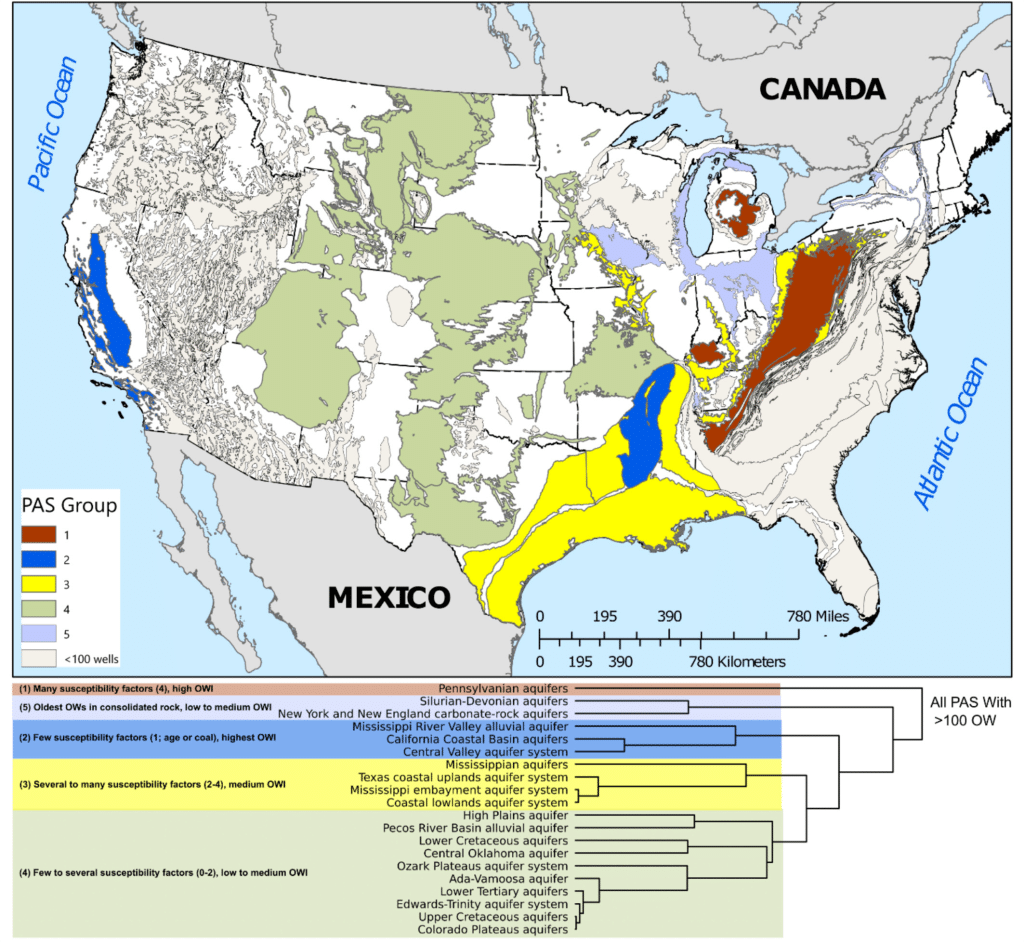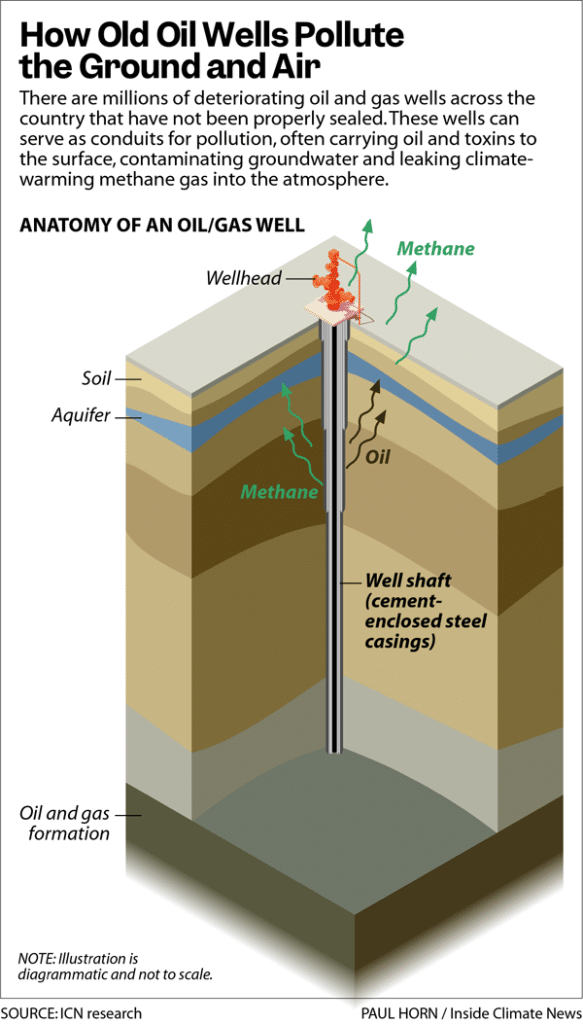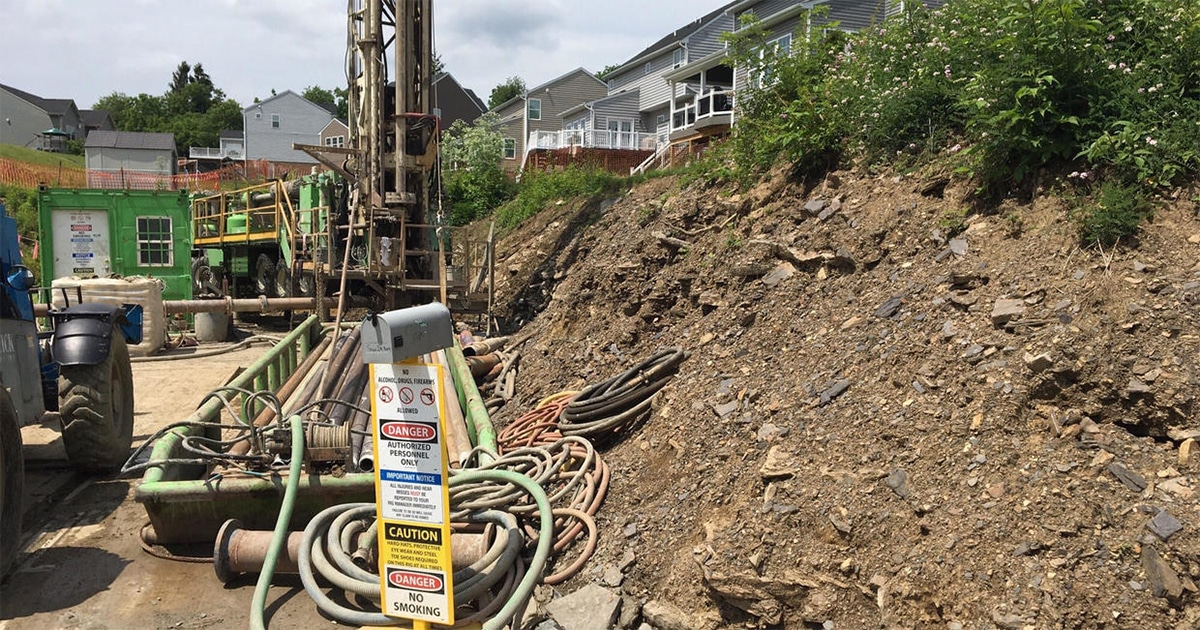This article originally appeared on Inside Climate News, a nonprofit, non-partisan news organization that covers climate, energy and the environment. Sign up for their newsletter here.
For the first time, scientists have mapped groundwater variables nationally to understand which aquifers are most vulnerable to contamination from orphan wells.
Oil and gas wells with no active owner that are no longer producing and have not been plugged are considered orphan wells. These unplugged wells can create pathways for contaminants like hydrocarbons and brine to migrate from the oil and gas formation into groundwater zones. Plugging a well seals off these potential pathways.
USGS scientists Joshua Woda, Karl Haase, Nicholas Gianoutsos, Kalle Jahn and Kristina Gutchess published a geospatial analysis of water-quality threats from orphan wells this month in the journal Science of the Total Environment. They found that factors including large concentrations of orphaned wells and the advanced age of wells make aquifers in Appalachia, the Gulf Coast and California susceptible to contamination.
Using a USGS dataset of 117,672 documented orphan wells nationwide, the researchers found that 54 percent of the wells are within aquifers that supply 94 percent of groundwater used nationally.
“No matter where you live across the nation, you can go look at what’s happening in your backyard, how your aquifers compare to other aquifers and what the threats are,” said Gianoutsos.
Orphan Wells Pockmark Major U.S. Aquifers
The researchers mapped the locations of orphaned wells over principal and secondary aquifers using Geographic Information Systems datasets. They then analyzed the aquifers based on factors that could contribute to vulnerability to groundwater contamination, such as the average age of the orphan wells.
Older wells were subject to less regulation and are more prone to failure. The authors found that Pennsylvanian aquifers, which span several Appalachian states including Pennsylvania, present the “maximum confluence” of risk factors. The first oil wells in the country were drilled in Pennsylvania. Orphan wells can be over 100 years old and located near coal seams and residential water wells.

The Gulf Coast aquifers, including the Coastal Lowlands aquifer system, which stretches from Texas to the Florida Panhandle, were found to be susceptible in part because wells are located in areas like wetlands and open water that are more prone to contamination.
The analysis also considered the rates of pumping from each aquifer. That led them to the California Coastal aquifers and the Central Valley, where a high density of old orphan wells overlaps with highly urbanized areas and intensive groundwater use for agriculture.
The researchers found that the Ada-Vamoosa aquifer, in central Oklahoma, has the highest concentration of orphan wells per square mile of any principal aquifer in the country.
The authors note the paper is not an analysis of the amount of groundwater contamination from orphan wells or the number of leaking orphan wells. But they suggest that policymakers and researchers could use it as a basis to target aquifers for additional investigation.
“It’s good to see a study that focuses on the water resources. We are going to have greater periods of drought, and these water resources are going to become far more valuable.”
“This could be a good starting point if someone wanted to do a local investigation,” said Woda.
Gianoutsos noted that the active list of orphan wells is changing as research into orphan wells and well plugging advances. He said some 40,000 orphan wells have been added to the national list since their dataset was created. Another approximately 10,000 orphan wells have been plugged in that time.
“The threats are still there,” he said. “Just as we discover more wells, we discover additional threats.”
The research was part of the U.S. Department of the Interior Orphaned Wells Program Office through the Bipartisan Infrastructure Law.
Parts of Pennsylvania Look like “Swiss Cheese” From Drilling
Orphan wells have been linked to groundwater contamination in states including Pennsylvania, Ohio and Texas. A 2011 Ground Water Protection Council study found that orphan wells caused 41 groundwater contamination incidents in Ohio between 1983 and 2007. The study found orphan wells and sites caused 30 groundwater contamination incidents in Texas between 1993 and 2008.
The Pennsylvania Department of Environmental Protection (DEP) has reported several recent cases of orphan wells contaminating groundwater. An orphan well in Vowinckel in Clarion County contaminated a family’s drinking water before it was plugged last year, according to the DEP. Another orphan well in Shinglehouse, in Potter County, was plugged by DEP in 2024 with emergency funds after a homeowner reported contamination of their water well.

John Stolz, a professor of environmental microbiology at Duquesne University in Pittsburgh, has researched how fluids from oil and gas wells can migrate underground with unintended consequences.
Stolz said some of the wells in Pennsylvania are so old they were cased with wood or metal, unlike the cement that has been standard for decades. He said the wooden casings have often deteriorated completely. He said conventional drilling and more recent fracking have left much of Pennsylvania “looking like Swiss cheese.”
“It’s good to see a study that focuses on the water resources,” he said in response to the USGS study. “We are going to have greater periods of drought, and these water resources are going to become far more valuable.”
Stolz is studying a “frack-out” in the town of New Freeport in southwestern Pennsylvania. An unconventional well being fracked communicated with an orphan well over 3,000 feet away, forcing fluids to the surface. Residents of the town resorted to drinking bottled water, according to NBC News.
“The industry refuses to admit this stuff happens,” he said. “The reality is it happens on a somewhat regular basis.”






